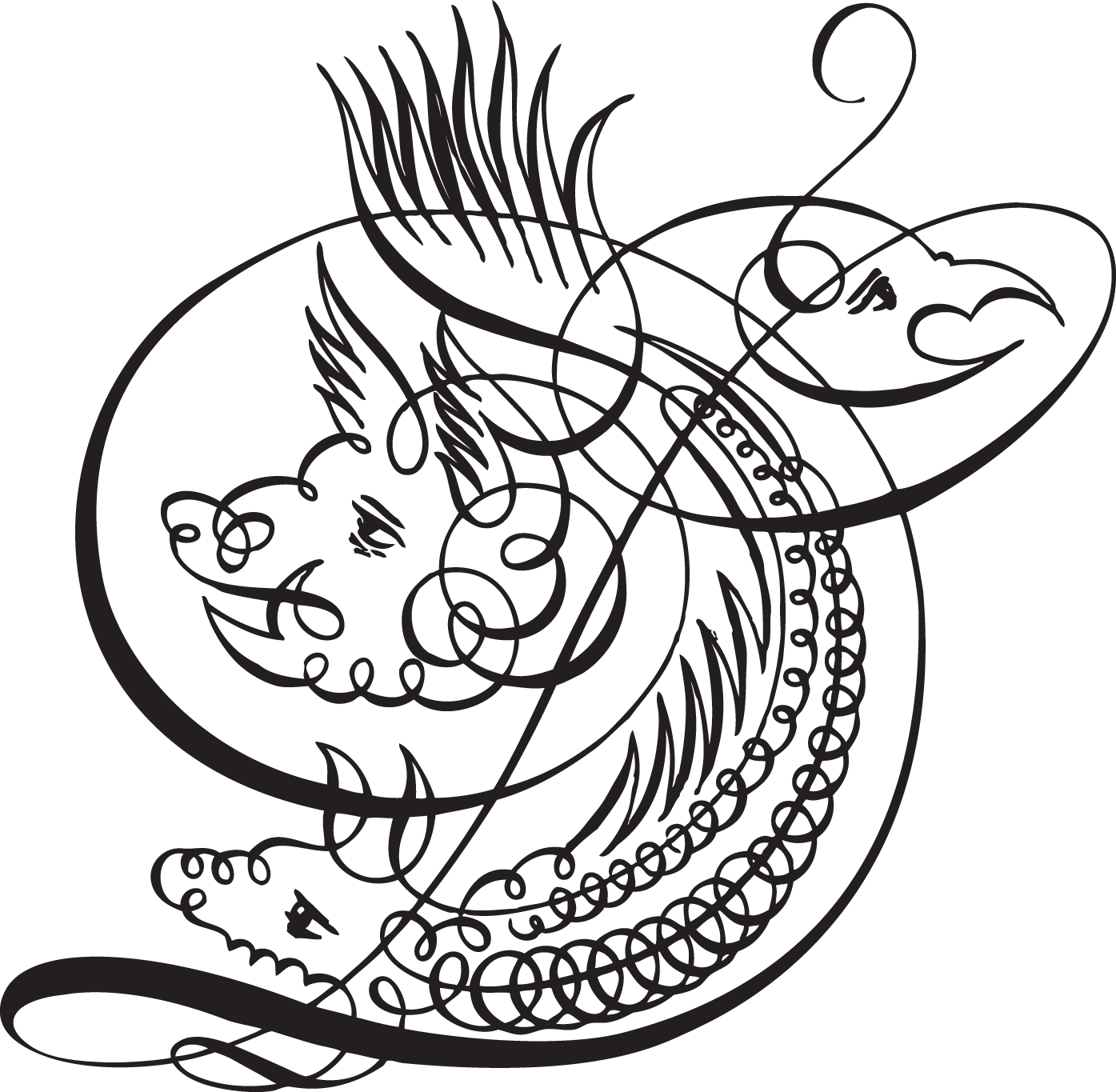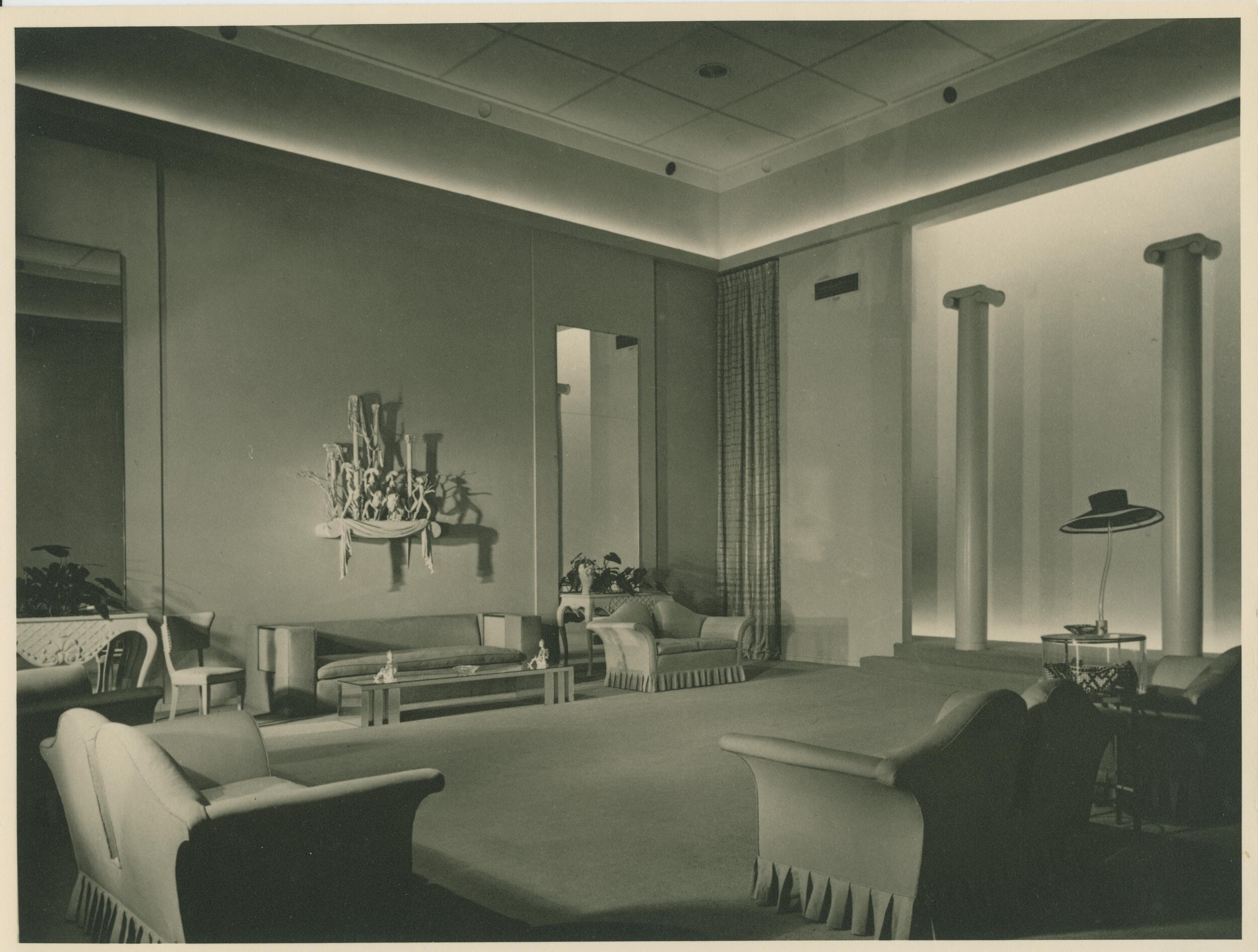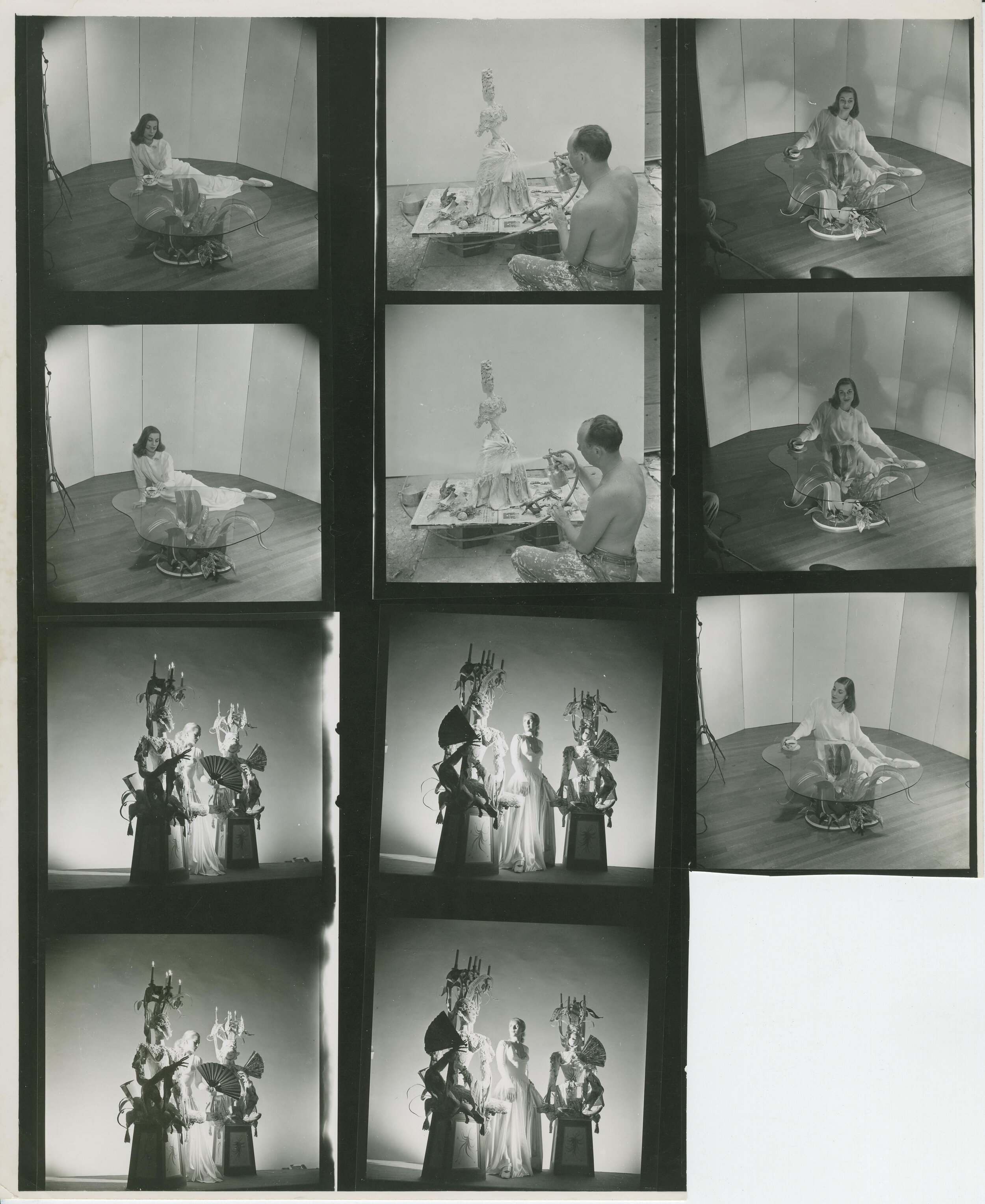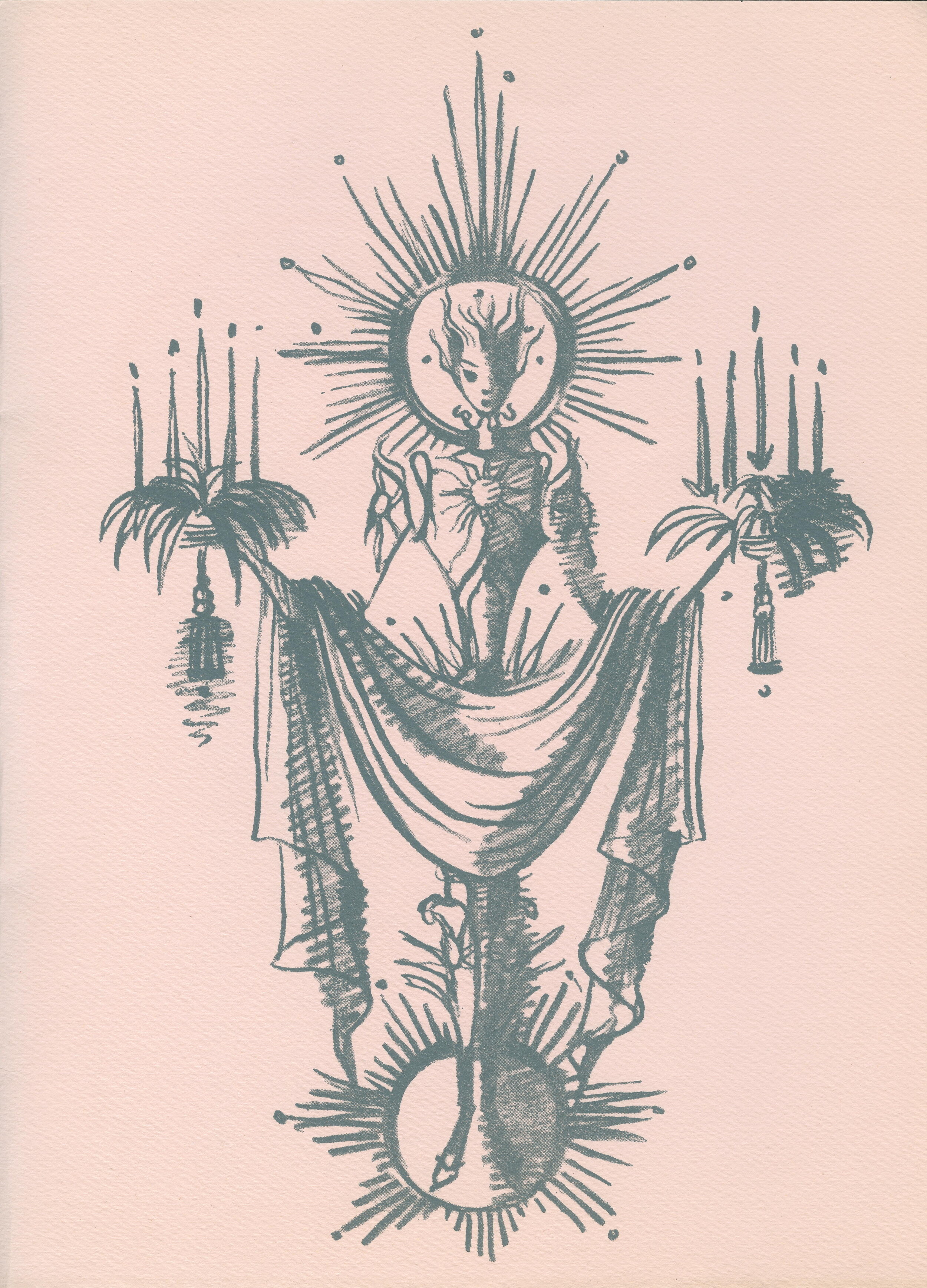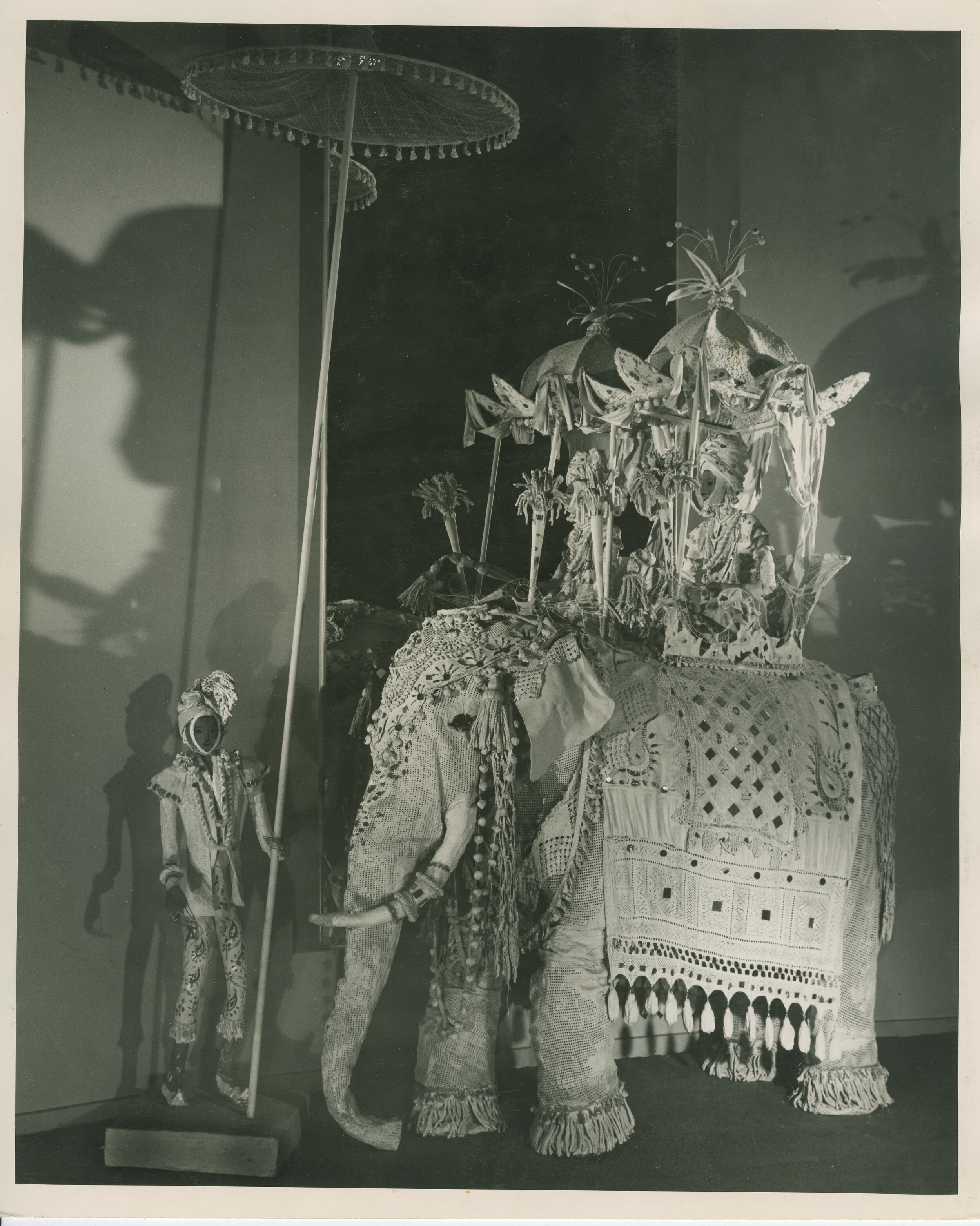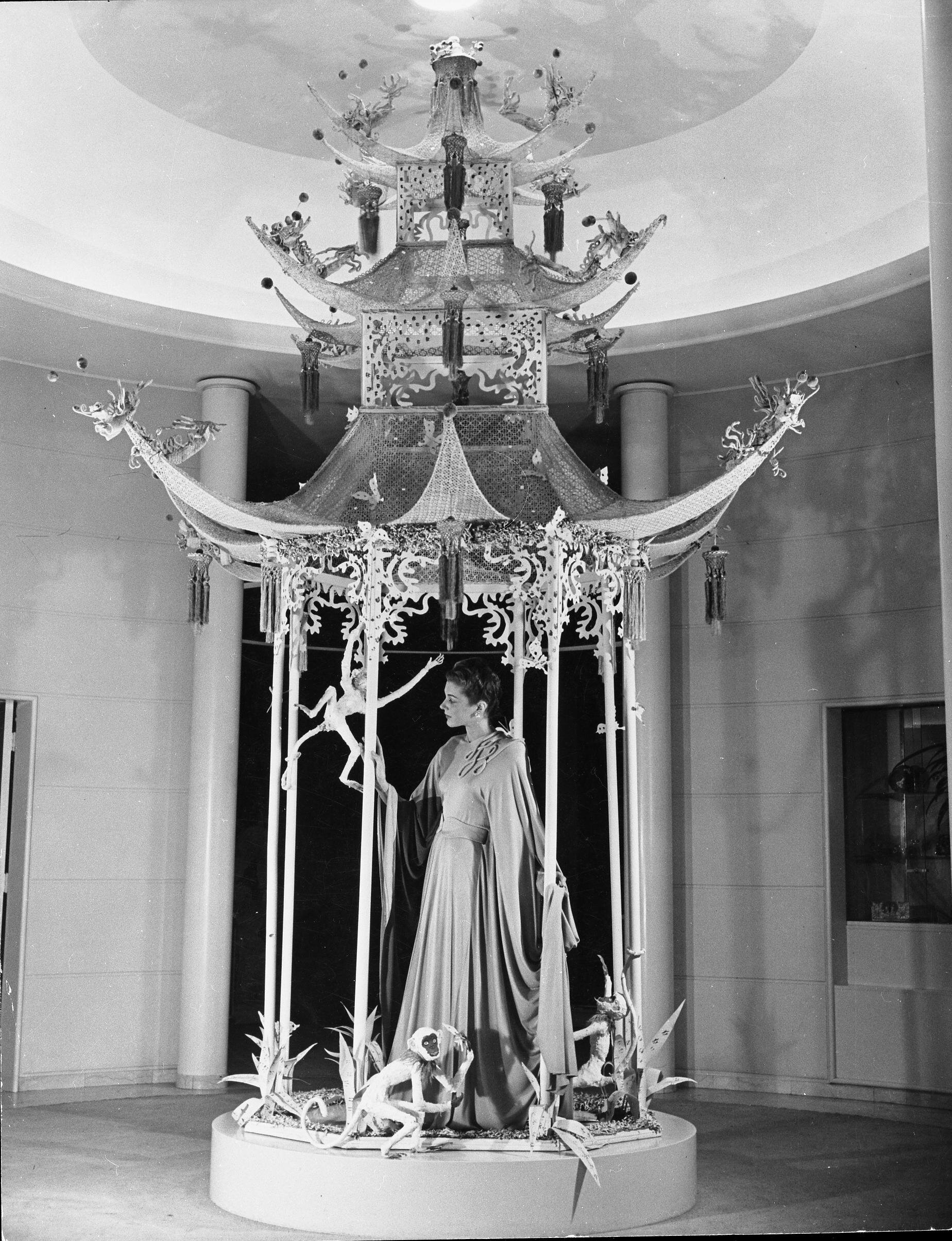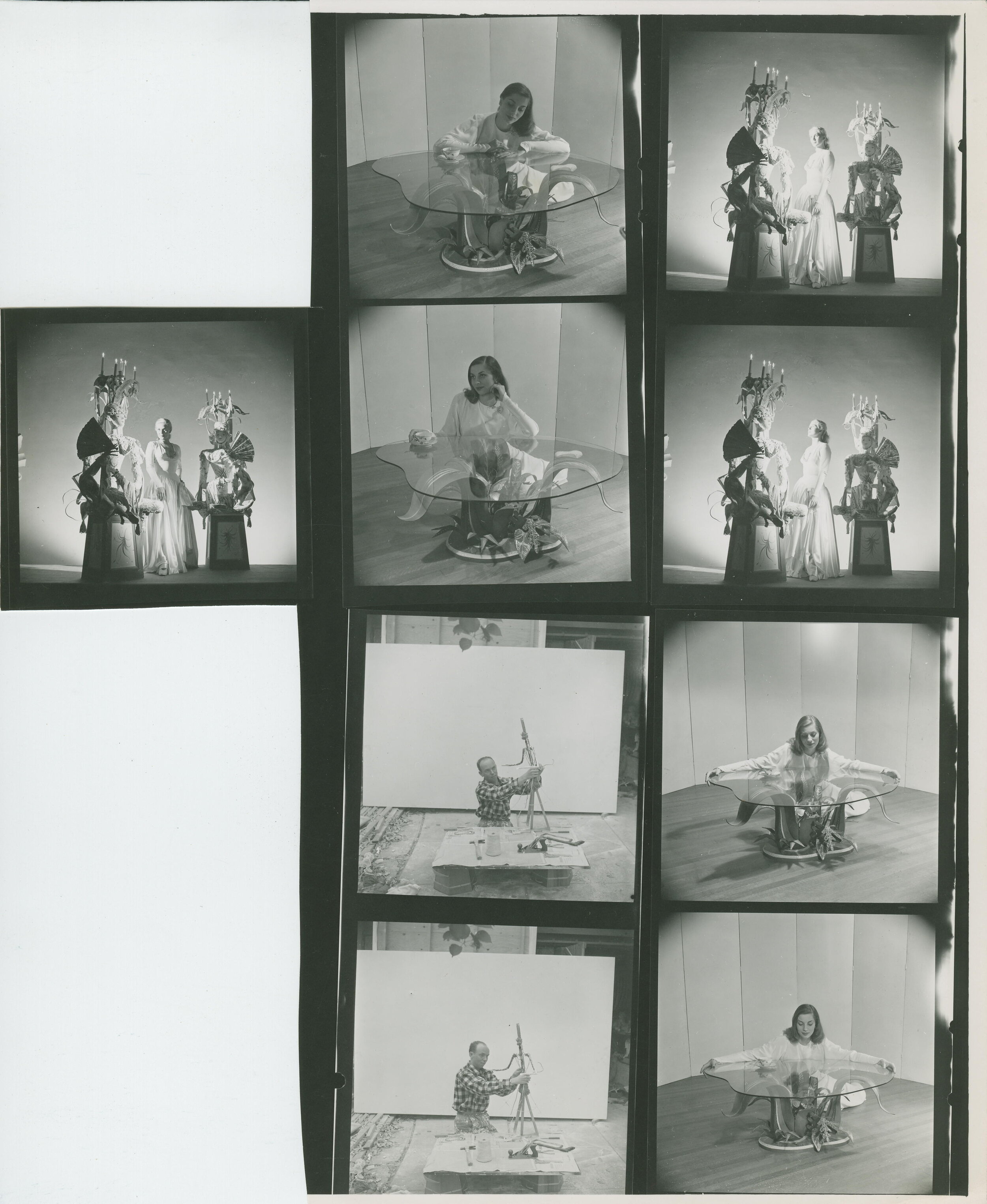Hutton Wilkinson * Tony Duquette Inc. is a full service interior design firm based in Beverly Hills with current projects in Los Angeles, New York, Palm Beach and Thailand with completed projects in Paris, Venice, Hawaii and Saudi Arabia.
Adrian Salon
Beverly Hills
TONY DUQUETTE’S RAJASTHANI INSPIRED WINDOWS FOR ADRIANS BEVERLY HILLS SALON.
A contact sheet showing a model in an Adrian gown with Tony Duquette’s figural candelabra (Credit: Sharland from Black star, Graybar building, New York).
An interior view of Adrians Beverly Hills salon, originally decorated by Eleanor Le Mare. Adrian later added many original Tony Duquette pieces including the wall hung sculpture over the sofa and the two “Ash Tray” men on the coffee table.
Tony Duquette at work in his Fountain Avenue studio constructing a fanciful figurine of wire dipped plaster and paint. (Credit: Sharland from Black Star, Graybar Building, New York).
A Tony Duquette pagoda display cabinet flanked by monkeys holds shoes in the Adrian windows on Beverly Dive in Beverly Hillss.
Tony duquette Palladian bridge for the entrance rotunda at Adrian’s Beverly Hills Salon. (Photograph by Beryl and Rene).
Tony Duquette was inspired by Rajasthan to create these decorations for Adrian’s Beverly Hills salon. The elephants and the attendants were made of wire, dipped plaster, mirrors and paint to compliment Adrian’s collection based on the drama of the sub-continent.
Adrian Salons
Tony Duquette plaster prop for the interior of Adrian’s, a Beverly Hills salon.
A program for Adrian’s collection for fall 1952 featured a Tony Duquette design for a figural candelabra wall sconce against a background of ‘Adrian Pink’.
Tony Duquette was inspired by Rajasthan to create these decorations for Adrian’s Beverly Hills Salon. The elephants and the attendants were made of wire, dipped plaster, mirrors and paint to compliment Adrian’s collection based on the drama of the sub-continent.
Tony Duquette’s Chinoiserie pagoda with monkeys for the entrance rotunda at Adiran’s Beverly Hills Salon.
A Tony Duquette mannequin and display for the millinery department of Adrian’s Salon in Beverly Hills. (Photographer Ross Carmichael, 401 Ocean Front, Santa Monica, CA).
Tony Duquette dipped plaster tent in the entrance rotunda of Adrian’s Beverly Hills Salon holds an antlered reindeer for the Christmas season. (Photographed by John Engstead, Beverly Hills).
Tony Duquette displays for the shoe department at Adrian’s Beverly Hills Salon. (Photographed by Ross Carmichael, 401 Ocean Front, Santa Monica, CA)
Tony Duquette plaster prop for the interior of Adrian’s, a Beverly Hills salon.
A display window from Adrian’s Beverly Hills salon featuring Tony Duquette’s trophy of bird cages, sheaves of wheat, gourds, grapes and pen and ink sketches. This war time window features a scroll reminding passersby to “Buy U.S. War Bonds”. (Photograph John Engstead, Beverly Hills).
Two “Ash Tray” men by Tony Duquette extolling the patrons at Adrian’s Salon to “Buy war bonds and stamps”. These fanciful table top decorations used by Adrian in his store helped to make Tony Duquette a household name in america. (Photograph by Rene Williams).
Tony Duquette in his Fountain Avenue studio making one of his fantasy figures with a wire armiture, gesso and paint. (Credit: Sharland from Black Star, Graybar Buiding, New York).
Tony Duquette’s wheat and Cornucopia pavilion for the entrance rotunda at Adrian’s Beverly Hills Salon. (Photographed by John Engstead, Beverly Hills).
Display windows designed by Tony Duquette for Adrians Beverly Hills Salon featured Adrian’s signature perfume “Saint” and “Sinner”. (Photographed by Beryl and Rene).
Tony Duquette monkeys and butterflies flank the dressing table mirror in the millinery department of Adrian’s Beverly Hills Salon.
Mocambo Club
Los Angeles
The Mocambo opened on January 3, 1941, and became an immediate success. Tony Duquette designed the club's Latin American themed decor which cost $100,000 (equivalent to $1,738,235 in 2019). Along the walls were glass cages holding live cockatoos, macaws, seagulls, pigeons and parrots. With big band music, the club became one of the most popular dance-till-dawn spots in town. On any given night, one might find the room filled with the leading men and women of the motion picture industry. In 1943, when Frank Sinatra became a solo act, he made his Los Angeles debut at the Mocambo
The bar at the Mocambo designed by Billy Haines c. 1941 exclusively with decorations specially created by Tony Duquette. Decorative themes included circus acts, tropical birds and fantasy figural bas reliefs in painted and jeweled plaster.
A top hatted and tail coated cat sits atop a plaster topiary tree all created as decorations for Mocambo by Tony Duquette.
One of the painted plaster and jeweled bas relief wall sconces which decorated the walls at Mocambo c. 1941.
A wire and painted gesso bird cage (with jeweled bird) created by Tony Duquette to decorate the Mocambo.
A painted plaster lamb by Tony Duquette walks the high wire high above Mocambo’s bar.
An entourage of Tony Duquette fantasy painted plaster pussycats dressed for a party parade atop the bar at Mocambo.
One of the painted plaster and jeweled bas relief wall sconces which decorated the walls at Mocambo c. 1941.
A painted plaster figural urn by Tony Duquette in the form of a lady wearing a fantastic headdress which holds flowers sits on a ledge between two windows in an early Duquette interior.
Elizabeth Arden, Beverly Hills
Interior of Elizabeth Arden offices in Beverly Hills designed by Tony Duquette, c. 1949.
Interior of Elizabeth Arden designed by Tony Duquette, c. 1950.
Interior of Elizabeth Arden offices in Beverly Hills designed by Tony Duquette, c. 1949
J.W. Robinson’s Department Store, Los Angeles
Tony Duquette in his studio creating figures for the windows of J.W. Robinson Co., Los Angeles, C. 1950
The swan window designed by Tony Duquette for J.W. Robinson’s 16th annual flower and perfume show in conjunction with local florists to promote Lentheric, Paris Perumes. (Photo: Dick Whittington)
“Pirate window designed by Tony Duquette for J.W. Robinson Co. Los Angeles 16th annual flower and perfume show in conjunction with local florists to promote Lentheric, Paris Perumes. (Photo: Dick Whittington)
Printed program for J.W. Robinson Co., Los Angeles 16th annual flower and perfume show in conjunction with local florists to promote Lentheric, Paris Perumes, interpreted in fresh cut flowers by southern California florists.
Window designed by Tony Duquette “Foret Vierge” for J.W. Robinson Co, 16th annual flower and perfume show in conjunction with local florists to promote Lentheric, Paris perfumes. (Photos by Dick Whittington).
Window designed by Tony Duquette “Anticipation” for J.W. Robinson Co, 16th annual flower and perfume show in conjunction with local florists to promote Lentheric, Paris perfumes. (Photos by Dick Whittington).
Window designed by Tony Duquette “Dark Brilliance” for J.W. Robinson Co, 16th annual flower and perfume show in conjunction with local florists to promote Lentheric, Paris perfumes. (Photos by Dick Whittington).
Window designed by Tony Duquette “Shanghai” for J.W. Robinson Co, 16th annual flower and perfume show in conjunction with local florists to promote Lentheric, Paris perfumes. (Photos by Dick Whittington).
Window designed by Tony Duquette “Anticipation” for J.W. Robinson Co, 16th annual flower and perfume show in conjunction with local florists to promote Lentheric, Paris perfumes. Note: Duquette was not employed by Robinson’s at this time but was brought in as a noted designer from the outside to do this job.
Window designed by Tony Duquette “Anticipation” for J.W. Robinson Co, 16th annual flower and perfume show in conjunction with local florists to promote Lentheric, Paris perfumes. (Photos by Dick Whittington).
Bullock’s Department Store, Los Angeles
While still in art school, Tony was hired by Bullocks department stores to change the interior of the store to reflect the seasons. Because Los Angeles has no discernible seasons and because in those days the ladies in LA were dressing in the same fashions and styles as the ladies in New york (in other words, if New York ladies were wearing tweed and furs where it was cold, tweeds and furs were worn by ladies in Los Angeles where it was warm). Therefore, it was Tony’s job to make the store interiors appear to change seasons.
Interior view of the ground floor at Bullock’s department store, Los Angeles, featuring “Easter” displays by Tony Duquette, c. 1940. Because Los Angeles had no noticeable change of seasons like the east coast had, it was Duquette’s job to make the store interiors change seasons, spring, summer, fall and winter. (Photo: Dick Whittington).
Interior view of the ground floor at Bullock’s department store, Los Angeles, featuring “Carnival” themed displays by Tony Duquette, c. 1940 (Photo: Dick Whittington).
Interior view of the ground floor at Bullock’s department store, Los Angeles, featuring “Carnival” themed display by Tony Duquette, c. 1940. (Photo: Dick Whittington).
Interior view of ground floor of Bullock’s department store, Los Angeles with Christmas displays by Tony Duquette c. 1940. Note: The Tony Duquette designed chandeliers placed over and around the existing hanging glass fixtures. (Photo: Dick Whittington).
Interior of the ground floor at Bullocks department store, Los Angeles, featuring Christmas displays by Tony Duquette, c. 1938. (Photo: Dick Whittington).
Hilton Hawaiian Village
Elizabeth (Beegle) Duquette in front of one of the large scale paintings she supplied to the décor of the Hilton Hawaiian village hotel job which her husband Tony Duquette was commissioned to decorate in the 1960’s.
A black and white photo of the lobby entrance to the Hilton Hawaiian village convention center designed by Tony Duqutte c. 1960’s. Note: the original Tony Duquette fabric mosaic tapestries depicting ancient Hawaiian legends flanked by his giant clam etagere planters with a grouping of his lighted resin furniture placed on Duquette’s custom woven tiger patterned carpet.
Tony Duquette seated in front of one of his fabric mosaic tapestries which tell the tale of captain cook and the ancient Hawaiians. the tapestries which he recessed into lighted alcoves at the Hilton Hawaiian village hotel were each flanked by a pair of Duquette’s original giant clam etager planters. the unique tiger patterned carpeting was designed by Duquette exclusively for this job. c. 1960’s.
A color rendering of the lobby entrance to the Hilton Hawaiian village convention center designed by Tony Duquette,c 1960’s.
A color rendering of the coral ballroom at the Hilton Hawaiian Village convention center designed by Tony Duquette. c. 1960’s
Hilton Hawaiian Village
the penthouse at the Hilton lagoon apartments was designed by Tony Duquette c. 1960’s using walls of crushed abalone, and Duquettes specially designed bronze and glass coffee table and crystal bouillote lamps Duquette painted the carved Thai reindeer on the terrace to resemble blue and white porcelain.
The penthouse at the Hilton lagoon apartments was designed by Tony Duquette c. 1960’s using walls of crushed abalone, and Duquette’s specially designed bronze and glass coffee table and crystal bouillote lamps. Duquette painted the carved Thai reindeer on the terrace to resemble blue and white porcelain.
Los Angeles Music Center
Los Angeles Music Center’s center stage curtain designed by Tony Duquette
